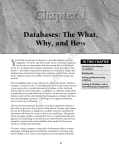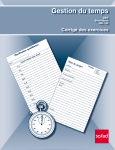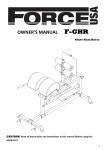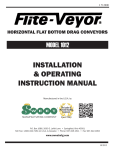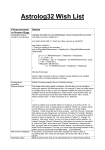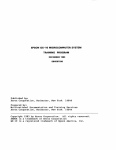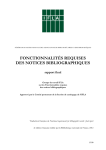Download Preview
Transcript
T MTH-5108-2 rigonometric Functions and Equations MTH-5108-2 TRIGONOMETRIC FUNCTIONS AND EQUATIONS Mathematics Project Coordinator: Jean-Paul Groleau Author: Alain Malouin Content Revision: Jean-Paul Groleau Pedagogical Revision: Jean-Paul Groleau Translation: Claudia de Fulviis Linguistic Revision: Johanne St-Martin Electronic Publishing: P.P.I. inc. Cover Page: Daniel Rémy First Edition: 2008 © Société de formation à distance des commissions scolaires du Québec All rights for translation and adaptation, in whole or in part, reserved for all countries. Any reproduction, by mechanical or electronic means, including microreproduction, is forbidden without the written permission of a duly authorized representative of the Société de formation à distance des commissions scolaires du Québec (SOFAD). Legal Deposit — 2008 Bibliothèque et Archives nationales du Québec Bibliothèque et Archives Canada ISBN 978-2-89493-307-7 Answer Key MTH-5108-2 Trigonometric Functions and Equations TABLE OF CONTENTS Introduction to the Program Flowchart .............................................. 0.4 Program Flowchart ............................................................................... 0.5 How to Use this Guide.......................................................................... 0.6 General Introduction ............................................................................ 0.9 Intermediate and Terminal Objectives of the Module........................ 0.10 Diagnostic Test on the Prerequisites ................................................... 0.19 Answer Key for the Diagnostic Test on the Prerequisites ................. 0.23 Analysis of the Diagnostic Test Results .............................................. 0.25 Information for Distance Education Students .................................... 0.27 UNITS 1. Converting from Degrees to Radians and from Radians to Degrees .. 1.1 2. The Wrapping Function ........................................................................ 2.1 3. Evaluating a Trigonometric Function for a Number Expressed in Radians ............................................................................ 3.1 4. Graphing a Trigonometric Function..................................................... 4.1 5. Graphing a Sinusoidal Function........................................................... 5.1 6. Fundamental Trigonometric Identities ................................................ 6.1 7. Proving Simple Trigonometric Identities ............................................. 7.1 8. Solving Simple Trigonometric Equations of the First or Second Degree................................................................ 8.1 9. Trigonometric Functions Involving a Sum or a Difference of Two Real Numbers ............................................................................ 9.1 10. Solving Problems Using Sinusoidal Functions .................................. 10.1 Final Review ........................................................................................ 11.1 Answer Key for the Final Review ...................................................... 11.10 Terminal Objectives ............................................................................ 11.17 Self-Evaluation Test ............................................................................ 11.21 Answer Key for the Self-Evaluation Test........................................... 11.33 Analysis of the Self-Evaluation Test Results..................................... 11.41 Final Evaluation .................................................................................. 11.43 Answer Key for the Exercises ............................................................. 11.45 Glossary ............................................................................................... 11.151 List of Symbols .................................................................................... 11.155 Bibliography ........................................................................................ 11.156 Review Activities ................................................................................. 12.1 © SOFAD 0.3 1 Answer Key 2 3 MTH-5108-2 Trigonometric Functions and Equations INTRODUCTION TO THE PROGRAM FLOWCHART WELCOME TO THE WORLD OF MATHEMATICS This mathematics program has been developed for adult students enrolled either with Adult Education Services of school boards or in distance education. The learning activities have been designed for individualized learning. If you encounter difficulties, do not hesitate to consult your teacher or to telephone the resource person assigned to you. The following flowchart shows where this module fits into the overall program. It allows you to see how far you have come and how much further you still have to go to achieve your vocational objective. There are three possible paths you can take, depending on your goal. The first path, which consists of Modules MTH-3003-2 (MTH-314) and MTH-4104-2 (MTH-416), leads to a Secondary School Vocational Diploma (SSVD) and certain college-level programs for students who take MTH-4104-2. The second path, consisting of Modules MTH-4109-1 (MTH-426), MTH-4111-2 (MTH-436) and MTH-5104-1 (MTH-514), leads to a Secondary School Diploma (SSD), which gives you access to certain CEGEP programs that do not call for a knowledge of advanced mathematics. Lastly, the path consisting of Modules MTH-5109-1 (MTH-526) and MTH-5111-2 (MTH-536) will lead to CEGEP programs that require a thorough knowledge of mathematics in addition to other abilities. Good luck! If this is your first contact with the mathematics program, consult the flowchart on the next page and then read the section "How to Use this Guide." Otherwise, go directly to the section entitled "General Introduction." Enjoy your work! 0.4 © SOFAD 1 Answer Key 2 3 MTH-5108-2 Trigonometric Functions and Equations PROGRAM FLOWCHART CEGEP MTH-5112-1 MTH-5111-2 MTH-536 MTH-5104-1 MTH-5103-1 MTH-5110-1 Introduction to Vectors MTH-5109-1 Geometry IV Trigonometric Functions and Equations MTH-5107-2 Exponential and Logarithmic Functions and Equations Optimization II MTH-5106-1 Real Functions and Equations Probability II MTH-5105-1 Conics MTH-5102-1 Statistics III MTH-5101-1 Optimization I MTH-4111-2 Trades DVS MTH-436 MTH-4110-1 MTH-4109-1 MTH-426 MTH-314 MTH-216 MTH-116 © SOFAD The Four Operations on Algebraic Fractions Sets, Relations and Functions MTH-4108-1 Quadratic Functions Straight Lines II MTH-4106-1 Factoring and Algebraic Functions MTH-4105-1 Exponents and Radicals MTH-4103-1 MTH-4102-1 MTH-4101-2 Complement and Synthesis I MTH-4107-1 MTH-4104-2 MTH-416 Complement and Synthesis II MTH-5108-2 MTH-526 MTH-514 Logic Statistics II Trigonometry I Geometry III Equations and Inequalities II MTH-3003-2 Straight Lines I MTH-3002-2 Geometry II MTH-3001-2 The Four Operations on Polynomials MTH-2008-2 Statistics and Probabilities I MTH-2007-2 Geometry I MTH-2006-2 Equations and Inequalities I MTH-1007-2 Decimals and Percent MTH-1006-2 The Four Operations on Fractions MTH-1005-2 The Four Operations on Integers 0.5 25 hours = 1 credit 50 hours = 2 credits You ar e h er e 1 Answer Key 2 3 MTH-5108-2 Trigonometric Functions and Equations HOW TO USE THIS GUIDE Hi! My name is Monica and I have been asked to tell you about this math module. What’s your name? Whether you are registered at an adult education center or pursuing distance education, ... Now, the module you have in your hands is divided into three sections. The first section is... I’m Andy. ... you have probably taken a placement test which tells you exactly which module you should start with. ... the entry activity, which contains the test on the prerequisites. 0.6 You’ll see that with this method, math is a real breeze! My results on the test indicate that I should begin with this module. By carefully correcting this test using the corresponding answer key, and recording your results on the analysis sheet ... © SOFAD 1 Answer Key 2 3 MTH-5108-2 Trigonometric Functions and Equations ... you can tell if you’re well enough prepared to do all the activities in the module. And if I’m not, if I need a little review before moving on, what happens then? In that case, before you start the activities in the module, the results analysis chart refers you to a review activity near the end of the module. Good! In this way, I can be sure I have all the prerequisites for starting. START The starting line shows where the learning activities begin. Exactly! The second section contains the learning activities. It’s the main part of the module. ? The little white question mark indicates the questions for which answers are given in the text. The target precedes the objective to be met. The memo pad signals a brief reminder of concepts which you have already studied. ? Look closely at the box to the right. It explains the symbols used to identify the various activities. The boldface question mark indicates practice exercises which allow you to try out what you have just learned. The calculator symbol reminds you that you will need to use your calculator. ? The sheaf of wheat indicates a review designed to reinforce what you have just learned. A row of sheaves near the end of the module indicates the final review, which helps you to interrelate all the learning activities in the module. FINISH Lastly, the finish line indicates that it is time to go on to the self-evaluation test to verify how well you have understood the learning activities. © SOFAD 0.7 1 Answer Key 2 3 MTH-5108-2 Trigonometric Functions and Equations There are also many fun things in this module. For example, when you see the drawing of a sage, it introduces a “Did you know that...” It’s the same for the “math whiz” pages, which are designed especially for those who love math. For example. words in boldface italics appear in the glossary at the end of the module... A “Did you know that...”? Yes, for example, short tidbits on the history of mathematics and fun puzzles. They are interesting and relieve tension at the same time. Must I memorize what the sage says? No, it’s not part of the learning activity. It’s just there to give you a breather. And the whole module has been arranged to make learning easier. They are so stimulating that even if you don’t have to do them, you’ll still want to. ... statements in boxes are important points to remember, like definitions, formulas and rules. I’m telling you, the format makes everything much easier. The third section contains the final review, which interrelates the different parts of the module. Great! There is also a self-evaluation test and answer key. They tell you if you’re ready for the final evaluation. Thanks, Monica, you’ve been a big help. I’m glad! Now, I’ve got to run. See you! 0.8 Later ... This is great! I never thought that I would like mathematics as much as this! © SOFAD 1 Answer Key 2 3 MTH-5108-2 Trigonometric Functions and Equations GENERAL INTRODUCTION TAKING TRIGONOMETRY A LITTLE FURTHER You have now reached the second-to-last module of the mathematics program. In this module, you will learn the concepts you will need if you wish to continue studying mathematics at the college level. This module will allow you to expand your knowledge of trigonometry. The first few units deal with various angular measures, the trigonometric circle and a new function called the wrapping function. We will be returning to familiar territory since we will be calculating sines, cosines, tangents, and so on. Note, however, that we will not be calculating these ratios in terms of a right triangle. Rather, we will be calculating them for real numbers on the trigonometric circle. A scientific calculator will definitely come in handy! In subsequent units, you will learn how to graph the six trigonometric functions and sinusoidal functions. You will also be required to state certain characteristics of the resulting curves. The last few units will give you the opportunity to prove both simple and complex trigonometric identities and to calculate the image of real numbers that can be expressed as a sum or a difference of two real numbers. We will provide the basic formulas that you may use as needed. Naturally, you will find some of the concepts and definitions covered in previous modules very helpful. These include definitions of trigonometric ratios and the characteristics of functions. In order to be able to prove identities more easily, you may need to perform operations on algebraic fractions and polynomials. Finally, you will be required to solve problems that involve applying concepts related to sinusoidal functions. And this, in a nutshell, is what you will be learning in this second module on trigonometry. © SOFAD 0.9 1 Answer Key 2 3 MTH-5108-2 Trigonometric Functions and Equations INTERMEDIATE AND TERMINAL OBJECTIVES OF THE MODULE Module MTH-5108-2 consists of 25 objectives and requires 50 hours of study, distributed as follows. The terminal objectives are shown in boldface. Objectives Number of hours* % (Evaluation) 1 to 3 4 10% 4 and 5 4 10% 6 and 7 5 10% 8, 9 and 10 5 10% 11, 12, 13 and 14 5 10% 15 to 17 5 10% 18 and 19 5 10% 20 and 21 5 10% 22 to 24 5 10% 25 5 10% * Two hours are allotted for the final evaluation. 0.10 © SOFAD 1 Answer Key 2 3 MTH-5108-2 Trigonometric Functions and Equations 1. Determining the measure of an angle Determine the measure of an angle in degrees or radians. 2. Converting angular measures from degrees to radians and vice versa Given the central angles of a circle, convert angular measures from degrees to radians and vice versa, convert angula measures fom radians to degrees. 3. Determining the coordinates of trigonometric points Using the unit circle and the wrapping function, determine the coordinates of the trigonometric points. 4. Finding the image of a trigonometric angle t under the wrapping function Find the image of a trigonometric angle t under the wrapping function. Determine the reference angle t' (0 ≤ t' ≤ 2π ) corresponding to angle t. Angle t is expressed in radians as nπ , nπ , nπ , nπ or nπ , 2 3 4 6 where n is a whole number. 5. Determining the measure in radians of a trigonometric angle t Determine the measure in radians of a trigonometric angle in a given interval using the coordinates of a trigonometric point. The interval is expressed as [nπ , nπ + 2π ], where n is a whole number. © SOFAD 0.11 1 Answer Key 2 3 MTH-5108-2 Trigonometric Functions and Equations 6. Defining trigonometric functions Define the trigonometric sine, cosine, tangent, cotangent, secant, and cosecant functions in the context of a unit circle and the wrapping function. 7. Evaluating the image of a trigonometric function Evaluate the image of a trigonometric function associated with a trigonometric angle. The angle is expressed in radians as nπ , nπ , nπ , nπ or nπ , where n is a whole number. 2 3 4 6 8. Graphing the sine, cosine and tangent functions Graph the sine, cosine and tangent functions in a given interval. 9. Determining the characteristics of the sine, cosine and tangent functions Using the rule or the graph of the sine, cosine and tangent functions, determine the characteristics of the functions. The following characteristics are studied: • domain and range; • image of an element of the domain; • elements(s) of the domain associated with a given image; • maximum and minimum; • zeros; • period; • y-intercept; • intervals of increase or decrease; • sign of the function; • equations of the asymptotes. 0.12 © SOFAD 1 Answer Key 2 3 MTH-5108-2 Trigonometric Functions and Equations 10. Comparing the characteristics of the sine, cosine and tangent functions Compare the characteristics of the sine, cosine and tangent functions over a given interval. 11. Graphing a sinusoidal function Graph a sinusoidal function of the form f (x) = asin b(x – h) + k or f (x) = acos b(x – h) + k and determine the connections between the change in the parameters of the rule and the transformation of the corresponding graph. 12. Determining the characteristics of a sinusoidal function Using the rule or the graph of a sinusoidal function, determine the characteristics of the function. The following characteristics are studied: • maximum and minimum; • amplitude; • period; • frequency; • domain and range; • sign of the function; • y-intercept; • zeros; • intervals of increase or decrease; • image of an element of the domain; • element(s) of the domain associated with a given image; • phase shift; • vertical translation. © SOFAD 0.13 1 Answer Key 2 3 MTH-5108-2 Trigonometric Functions and Equations 13. Determining the rule of a sinusoidal function Determine the rule of a sinusoidal function given relevant information or the graph of the function. 14. Comparing the characteristics of two sinusoidal functions Compare the characteristics of two sinusoidal functions given their graph. 15. Proving the fundamental identities Prove the fundamental trigonometric identities: • sin2 t + cos2 t = 1; • tan2 t + 1 = sec2 t; • 1 + cot2 t = csc2 t. 16. Applying the fundamental identities and trigonometric ratios Apply the fundamental identities and the definitions of the trigonometric ratios to the transformation of simple trigonometric expressions. 17. Determining the value of the other trigonometric ratios using a known trigonometric ratio Given the value of a trigonometric ratio at one point within a designated interval, determine the value of the other trigonometric ratios at this point using the fundamental identities. The interval corresponds to an arc of no more than π radians and its limits are π multiples of 2 . 0.14 © SOFAD 1 Answer Key 2 3 MTH-5108-2 Trigonometric Functions and Equations 18. Simplifying and factoring trigonometric expressions Perform the four operations on trigonometric expressions, simplify trigonometric expressions and factor trigonometric expressions. 19. Proving a simple trigonometric identity Prove a simple trigonometric identity. The expression should consist of no more than two terms on each side of the equality. Each term should contain no more than two trigonometric ratios. The definitions of trigonometric ratios and the fundamental identities will not be provided during examinations. 20. Finding the image of an angle given in radian measure for a given trigonometric function Using a calculator, find the image of an angle given in radian measure for a given trigonometric function. In addition, given the value of a trigonometric function expressed as a real number, determine the corresponding trigonometric angle over a given interval or in . The limits of the interval are multiples of π. 21. Solving a simple trigonometric equation of the first or second degree Solve a simple trigonometric equation of the first or second degree over a given interval or in , using the trigonometric circle or a calculator. The solution may require simple factorization. The limits of the interval must be multiples of π . © SOFAD 0.15 1 Answer Key 2 3 MTH-5108-2 Trigonometric Functions and Equations 22. Verifying trigonometric identities related to a sum, a difference or twice the value of a real number Using simple examples, verify the trigonometric identities related to a sum, a difference or twice the value of a real number: • sin (A + B) = sin A cos B + cos A sin B; • sin (A – B) = sin A cos B – cos A sin B; • cos (A + B) = cos A cos B – sin A sin B; • cos (A – B) = cos A cos B + sin A sin B; • tan (A + B) = tan A + tan B , where 1 – tan A tan B ≠ 0; 1 – tan A tan B • tan (A – B) = tan A + tan B , where 1 + tan A tan B ≠ 0; 1 – tan A tan B • sin 2A = 2sin A cos A; • cos 2A = cos2 A – sin2 A; • tan 2A = 2tan A , where 1 – tan2 A ≠ 0. 1 – tan 2 A 23. Proving the cofunction identities, the odd-even identities, the double-angle identities or a reduction formula Using the trigonometric identies related to a sum or a difference of real numbers, prove the cofunction identities, the odd-even identities, the double-angle identities or a reduction formula: • when the proof involves identities related to the sine or cosine, A or B is a multiple of π or a variable. 2 • when the proof involves identities related to the tangent function, A or B is a multiple of π or a variable. 4 N.B. The formulas will be provided during examinations. 0.16 © SOFAD 1 Answer Key 2 3 MTH-5108-2 Trigonometric Functions and Equations 24. Simplifying a trigonometric expression using trigonometric identities related to a sum, a difference or twice the value of a real number Simplify a trigonometric expression using trigonometric identities related to a sum, a difference or twice the value of a real number. The expression should not consist of more than two terms on each side of the equality and the expression should consist of no more than four trigonometric functions. 25. Solving problems that require applying concepts related to sinusoidal functions Solve problems that require applying concepts related to sinusoidal functions. The solution may involve finding the rule of a sinusoidal function, describing certain characteristics of a sinusoidal function, determining the connections between the change in the parameters of the rule and the transformation of the corresponding graph, or comparing certain characteristics of different sinusoidal functions over a given interval. © SOFAD 0.17 1 Answer Key 2 3 MTH-5108-2 Trigonometric Functions and Equations This module comprises 25 objectives, grouped as follows. Unit 1 2 Objective(s) Determining the measure of an angle Converting angular measures from degrees to radians and vice versa 1 2 Determining the coordinates of trigonometric points Finding the image of a trigonometric angle t under the wrapping function Determining the measure in radians of a trigonometric angle t 5 3 Defining trigonometric functions Evaluating the image of a trigonometric function 6 7 4 Graphing the sine, cosine and tangent functions Determining the characteristics of the sine, cosine and tangent functions Comparing the characteristics of the sine, cosine and tangent functions 8 5 6 Graphing a sinusoidal function Determining the characteristics of a sinusoidal function Determining the rule of a sinusoidal function Comparing the characteristics of two sinusoidal functions 3 4 9 10 11 12 13 14 Proving fundamental identities Applying fundamental identities and trigonometric ratios Determining the value of the other trigonometric ratios using a known trigonometric ratio 17 7 Simplifying and factoring trigonometric expressions Proving a simple trigonometric identity 18 19 8 Finding the image of an angle given in radian measure for a given trigonometric function Solving a simple trigonometric equation of the first or second degree 9 10 15 16 20 21 Verifying trigonometric identities related to a sum, a difference or twice the value of a real number Proving the cofunction identities, the odd-even identities, the double-angle identities or a reduction formula Simplifying a trigonometric expression using trigonometric identities related to a sum, a difference or twice the value of a real number 24 Solving problems that require applying concepts related to sinusoidal functions 25 0.18 22 23 © SOFAD 1 Answer Key 2 3 MTH-5108-2 Trigonometric Functions and Equations DIAGNOSTIC TEST ON THE PREREQUISITES Instructions 1. Answer as many questions as you can. 2. Do not use a calculator. 3. Write your answers on the test paper. 4. Do not waste any time. If you cannot answer a question, go on to the next one immediately. 5. When you have answered as many questions as you can, correct your answers using the answer key which follows the diagnostic test. 6. To be considered correct, your answers must be identical to those in the answer key. In addition, the various steps in your solution should be equivalent to those shown in the answer key. 7. Transcribe your results on the chart which follows the answer key. This chart will help you analyze your diagnostic text results. 8. Do only the review activities that apply to each of your incorrect answers. 9. If all your answers are correct, you may begin working on this module. © SOFAD 0.19 1 Answer Key 2 3 MTH-5108-2 Trigonometric Functions and Equations 1. Find the prime factors of the following polynomials. a) a2x + ay = ..................................................................................................... b) x2y2 + y = ...................................................................................................... c) x2 – y2 = ........................................................................................................ d) x2y – y = ........................................................................................................ e) a4 – b4 = ........................................................................................................ f) a2x2 + x2 = ..................................................................................................... 2. Calculate the following products. a) m(m – n) = .................................. b) ab(a + b) = ..................................... c) x(1 – x) = ..................................... d) (2 – 3y)(– xy) =................................ e) (m + n)(m – n) = ......................... f) (2r – s)(2r + s) = ............................. g) (m + n)2 = ..................................................................................................... h) (2x – y)2 = ..................................................................................................... 0.20 © SOFAD 1 Answer Key 2 3 MTH-5108-2 Trigonometric Functions and Equations 3. Reduce each of the following algebraic fractions to their simplest form. 2 2 2 a) 6a = ......................................... b) a +2 b = ...................................... 3a a c) a(x + y) a 2(a + b) = ................................. d) = ..................................... a a 2x e) xy 2 + x = ..................................................................................................... x f) a 2 + 2ab + b a2 – b2 2 = ........................................................................................... 2x 2 y + (y 2 – x 2)y g) = ..................................................................................... xy 4. Calculate the following products. a) x3 × 2 y y b) x 2 × x × 1 2 = .................................... x = ................................ x y + b × bc = .......................................................................................... c) a ac a+b 5. Calculate the following quotients. a) 1 a 2 = .......................................... b) 1 b2 c) a × c b a2 = .................................................................................................... 1 2 b y x = ............................................. 1 x2 1 + xy d) y = ...................................................................................................... 1+ x © SOFAD 0.21 1 Answer Key 2 3 MTH-5108-2 Trigonometric Functions and Equations 6. Calculate the following sums and differences. The result must be reduced to its simplest form. a) xy + 1 = ....................................................................................................... y b) xy – x = ...................................................................................................... c) 1 + x + 1 = ................................................................................................. 1+y d) 1 + 1 = .......................................................................................... a–b a+b 1 – 1 = .......................................................................................... e) x – y x+y ....................................................................................................................... 0.22 © SOFAD 1 Answer Key 2 3 MTH-5108-2 Trigonometric Functions and Equations ANSWER KEY FOR THE DIAGNOSTIC TEST ON THE PREREQUISITES 1. a) a2x + ay = a(ax + y) b) x2y2 + y = y(x2y + 1) c) x2 – y2 = (x + y)(x – y) d) x2y – y = y(x2 – 1) = y(x + 1)(x – 1) e) a4 – b4 = (a2 + b2)(a2 – b2) = (a2 + b2)(a + b)(a – b) f) a2x2 + x2 = x2(a2 + 1) 2. a) m(m – n) = m2 – mn c) x(1 – x) = x – x2 b) ab(a + b) = a2b + ab2 d) (2 – 3y)(–xy) = –2xy + 3xy2 e) (m + n)(m – n) = m2 – n2 f) (2r – s)(2r + s) = 4r2 – s2 g) (m + n)2 = (m)2 + 2(m)(n) + (n)2 = m2 + 2mn + n2 h) (2x – y)2 = (2x)2 – 2(2x)(y) + (y)2 = 4x2 – 4xy + y2 2 3. a) 6a = 2a 3a c) a 2(a + b) = a(a + b) a e) xy 2 + x x(y 2 + 1) = = y2 + 1 x x © SOFAD 2 2 b) a +2 b cannot be simplified. a d) 0.23 a(x + y) x + y = ax a 2x 1 Answer Key 2 3 MTH-5108-2 Trigonometric Functions and Equations 2 f) 2 (a + b) (a + b)(a + b) a + b a 2 + 2ab + b = = = 2 2 (a + b)(a – b) (a + b)(a – b) a – b a –b g) 2x 2 y + ( y 2 – x 2) y 2x 2 y + y 3 – x 2 y x 2 y + y 3 y(x 2 + y 2) x 2 + y 2 = = = = xy xy xy xy x 4. a) x 3 × y x3 × y = xy = 2 x2 x 2 y x 2y 1 = b) x 2 × x × 1 x x 2y 2 = y y + b × bc = (a + b)bc = b c) aac a + b ac(a + b) a 5. a) 1 2 2 a2 = 1 × b = b 1 1 a2 a2 2 b b) y x = y × x 2 = xy x 1 1 2 x c) a × c b a2 = 1 b2 c 2 ab = c × b = bc a 1 1 ab 2 b y+x 1 + xy y x+y x x d) y = x+y = y × x+y = y 1+ x x y x+y 6. a) xy + 1 = xy + y = y y x 2 – y 2 = x 2 – y 2 or x + y x – y b) xy – x = xy xy xy xy 1+ y 2+ x+ y c) 1 + x + 1 = 1 + x + = 1+ y 1+ y 1+ y 1+ y d) a+b a–b 1 + 1 = + = a – b a + b (a – b)(a + b) (a – b)(a + b) 2a or 22a 2 (a – b)(a + b) a –b x+y x– y (x + y) – (x – y) 1 – 1 = e) x – y x + y (x – y)(x + y) – (x – y)(x + y) = (x – y)(x + y) = 2y 2y x+y–x+y = or 2 (x – y)(x + y) (x – y)(x + y) x – y2 0.24 © SOFAD 1 Answer Key 2 3 MTH-5108-2 Trigonometric Functions and Equations ANALYSIS OF THE DIAGNOSTIC TEST RESULTS Answers Questions Correct Incorrect 1. a) b) c) d) e) f) 2.a) b) c) d) e) f) g) h) 3.a) b) c) d) e) f) g) 4.a) b) c) 5.a) b) c) d) 6.a) b) c) d) e) © SOFAD Review Section Page Before going on to 12.1 12.1 12.1 12.1 12.1 12.1 12.2 12.2 12.2 12.2 12.2 12.2 12.2 12.2 12.3 12.3 12.3 12.3 12.3 12.3 12.3 12.4 12.4 12.4 12.4 12.4 12.4 12.4 12.5 12.5 12.5 12.5 12.5 12.4 12.4 12.4 12.4 12.4 12.4 12.17 12.17 12.17 12.17 12.17 12.17 12.17 12.17 12.21 12.21 12.21 12.21 12.21 12.21 12.21 12.24 12.24 12.24 12.24 12.24 12.24 12.24 12.30 12.30 12.30 12.30 12.30 Unit 7 Unit 7 Unit 7 Unit 7 Unit 7 Unit 7 Unit 7 Unit 7 Unit 7 Unit 7 Unit 7 Unit 7 Unit 7 Unit 7 Unit 7 Unit 7 Unit 7 Unit 7 Unit 7 Unit 7 Unit 7 Unit 7 Unit 7 Unit 7 Unit 7 Unit 7 Unit 7 Unit 7 Unit 7 Unit 7 Unit 7 Unit 7 Unit 7 0.25 1 Answer Key 2 3 MTH-5108-2 Trigonometric Functions and Equations • If all your answers are correct, you may begin working on this module. • For each incorrect answer, find the related section listed in the Review column. Do the review activities for that section before beginning the units listed in the right-hand column under the heading Before going on to. 0.26 © SOFAD 1 Answer Key 2 3 MTH-5108-2 Trigonometric Functions and Equations INFORMATION FOR DISTANCE EDUCATION STUDENTS You now have the learning material for MTH-5108-2 and the relevant homework assignments. Enclosed with this package is a letter of introduction from your tutor, indicating the various ways in which you can communicate with him or her (e.g. by letter or telephone), as well as the times when he or she is available. Your tutor will correct your work and help you with your studies. Do not hesitate to make use of his or her services if you have any questions. DEVELOPING EFFECTIVE STUDY HABITS Learning by correspondence is a process which offers considerable flexibility, but which also requires active involvement on your part. It demands regular study and sustained effort. Efficient study habits will simplify your task. To ensure effective and continuous progress in your studies, it is strongly recommended that you: • draw up a study timetable that takes your work habits into account and is compatible with your leisure and other activities; • develop a habit of regular and concentrated study. © SOFAD 0.27 1 Answer Key 2 3 MTH-5108-2 Trigonometric Functions and Equations The following guidelines concerning theory, examples, exercises and assignments are designed to help you succeed in this mathematics course. Theory To make sure you grasp the theoretical concepts thoroughly: 1. Read the lesson carefully and underline the important points. 2. Memorize the definitions, formulas and procedures used to solve a given problem; this will make the lesson much easier to understand. 3. At the end of the assignment, make a note of any points that you do not understand using the sheets provided for this purpose. Your tutor will then be able to give you pertinent explanations. 4. Try to continue studying even if you run into a problem. However, if a major difficulty hinders your progress, contact your tutor before handing in your assignment, using the procedures outlined in the letter of introduction. Examples The examples given throughout the course are applications of the theory you are studying. They illustrate the steps involved in doing the exercises. Carefully study the solutions given in the examples and redo the examples yourself before starting the exercises. 0.28 © SOFAD 1 Answer Key 2 3 MTH-5108-2 Trigonometric Functions and Equations Exercises The exercises in each unit are generally modeled on the examples provided. Here are a few suggestions to help you complete these exercises. 1. Write up your solutions, using the examples in the unit as models. It is important not to refer to the answer key found on the coloured pages at the back of the module until you have completed the exercises. 2. Compare your solutions with those in the answer key only after having done all the exercises. Careful! Examine the steps in your solutions carefully, even if your answers are correct. 3. If you find a mistake in your answer or solution, review the concepts that you did not understand, as well as the pertinent examples. Then redo the exercise. 4. Make sure you have successfully completed all the exercises in a unit before moving on to the next one. Homework Assignments Module MTH-5108-2 comprises three homework assignments. The first page of each assignment indicates the units to which the questions refer. The assignments are designed to evaluate how well you have understood the material studied. They also provide a means of communicating with your tutor. When you have understood the material and have successfully completed the pertinent exercises, do the corresponding assignment right away. Here are a few suggestions: 1. Do a rough draft first, and then, if necessary, revise your solutions before writing out a clean copy of your answer. © SOFAD 0.29 1 Answer Key 2 3 MTH-5108-2 Trigonometric Functions and Equations 2. Copy out your final answers or solutions in the blank spaces of the document to be sent to your tutor. It is best to use a pencil. 3. Include a clear and detailed solution with the answer if the problem involves several steps. 4. Mail only one homework assignment at a time. After correcting the assignment, your tutor will return it to you. In the section "Student’s Questions," write any questions which you wish to have answered by your tutor. He or she will give you advice and guide you in your studies, if necessary. In this course Homework Assignment 1 is based on units 1 to 5. Homework Assignment 2 is based on units 6 to 10. Homework Assignment 3 is based on units 1 to 10. CERTIFICATION When you have completed all your work, and provided you have maintained an average of at least 60%, you will be eligible to write the examination for this course. 0.30 © SOFAD 1 Answer Key 2 3 MTH-5108-2 Trigonometric Functions and Equations START UNIT 1 CONVERTING FROM DEGREES TO RADIANS AND FROM RADIANS TO DEGREES 1.1 SETTING THE CONTEXT Having Fun with Your Scientific Calculator Have you ever wondered what the DRG key on your scientific calculator is used for? Press this key and you will see the DEG, RAD or GRAD modes displayed successively on your calculator, even though no value appears on the screen. These abbreviations stand for three different units of angular measure, namely degres, radians and grads. Some calculators have a second function: 2ndF in DEG mode, enter 90 and then press 2ndF DRG 䊳 . Put you calculator DRG 䊳 . You will see 1.570796327 in RAD mode displayed. Press the same keys again, and 100 in GRAD mode will be displayed. © SOFAD 1.1 1 Answer Key 2 3 MTH-5108-2 Trigonometric Functions and Equations To achieve the objective of this unit, you should be able to convert angular measures from degrees to radians and vice versa. There are three different units of angular measures: degrees, radians and grads. You are already familiar with degrees. For a number of years now, you have been using a protractor, which allows you to measure an angle in degrees. You probably know that a degree corresponds to the measure of the angle between two consecutive radii when a circle is divided into 360 equal parts. In other words, an angle of 1° intercepts an arc equal in length to 1 of the circle's 360 circumference. One degree (1°) is subdivided into 60 minutes and one minute (1') is subdivided into 60 seconds (60"). These angular units should not be confused with the units of time of the same name. Divisions of degrees can also be represented using decimal notation: for example, 12°30' is equivalent to 12.5°. The second unit of angular measure is the grad. As you may have noted from the statement of the objective, we will not be using grads in this module. Note, however, that one grad is equal to 1 of a circle's circumference and the symbol 400 for grad is gr. The third unit of angular measure is the radian. One radian is the measure of a central angle which intercepts an arc of a circle equal in length to the radius of the circle. In other words, a central angle which intercepts an arc equal in length to the radius of the circle measures one radian. The symbol for radian is rad. 1.2 © SOFAD 1 Answer Key 2 3 MTH-5108-2 Trigonometric Functions and Equations r O 1 rad r r Fig. 1.1 Central angle of 1 radian intercepting an arc of the same length as the radius To make our task easier, we will use a circle whose radius is one unit in length. In this case, a central angle of 1 radian intercepts an arc of a circle 1 unit in length. ? In a unit circle, an angle of .................. intercepts an arc two units in length. If your answer is 2 rad, then you have understood the explanation given above. Let us continue. Since the circumference of a unit circle is 2π (C = 2πr = 2π × 1), the central angle which intercepts the entire circumference measures 2π rad. ? Complete the following statement. The central angle which intercepts half of a circle's circumference measures ............. rad; a central angle which intercepts one quarter of a circle's circumference measures ................ rad. Solution The central angle which intercepts half of a circle's circumference measures 1 π rad, since 1 the circumference = 2 × 2π = π, and a central angle which 2 intercepts one quarter of a circle's circumference measures π rad, since 1 the 4 2 circumference = 1 × 2π = π . 2 4 © SOFAD 1.3 1 Answer Key 2 3 MTH-5108-2 Trigonometric Functions and Equations If we compare the two units of angular measure, we obtain the following. 360° = 2π rad 180° = π rad 90° = π rad 2 We will use the second equality, or π rad = 180°, to do conversions. When used in a proprotion, this equality allows us to convert from degrees to radians, and vice versa. Example 1 An angle measures 210°. What is the measure of this angle in radians? Solution π rad = 180° ? = 210° The proportion can be written as follows. π rad = 180° x 210° 180° × x = 210° × π rad x = 210° × π rad 180° x = 7π rad 6 * The answer is 7π rad. 6 In future, we will write out only the step marked with an asterisk (*); however, if you have any doubts, feel free to use the original proportion. 1.4 © SOFAD 1 Answer Key 2 3 MTH-5108-2 Trigonometric Functions and Equations Exercise 1.1 Convert the following degree measures, to radians. 1. 45°: ................................................... 2. 30°: ................................................. 3. 15°: ................................................... 4. 120°: ............................................... 5. 300°: ................................................. 6. 225°: ............................................... Example 2 Given an angle of 37°30', express this value in radians. First, convert 30' to a decimal fraction expressed in degrees. If 1° = 60', then 30' = 30' = 0.5°. 60' An angle of 37°30' is therefore an angle of 37.5° in decimal notation. Hence, x= 37.5° × π rad 5π = rad . 24 180° Observations You can use your calculator to convert 37°30' to 37.5°, as follows: 37 D°M'S 37°00 30 2nd F ↔DEG 37.5 N.B. Some calculators use the symbol →DEG rather than ↔DEG , but the result is the same. To go back a step, simply press the 2nd F © SOFAD ↔DEG on others. 1.5 D°M'S key on certain models or 1 Answer Key 2 3 MTH-5108-2 Trigonometric Functions and Equations If your calculator does not function in this way, refer to the user manual or consult a resource person, if possible. You can also use a graphing calculator for this type of conversion. To convert 90° to radians, proceed as follows: MODE Select Radian ENTER and CLEAR to get back to the screen. 9 0 2nd ANGLE 1 ENTER 1.570796327 should appear on the screen. Conversely, to convert π to degrees, proceed as follows: 2 MODE Select degree ENTER and CLEAR . ( 2nd π ÷ 2 ) 2nd ANGLE 3 ENTER 90 should appear on the screen. As you may have noticed up to now, all radian measures have been given in terms of π. But is this always the case? Let us look at the following example. 1.6 © SOFAD 1 Answer Key 2 3 MTH-5108-2 Trigonometric Functions and Equations Example 3 Given an angle of 18°15'30", express this value in radians. • First, convert 18°15'30" to decimal form. Convert the seconds to minutes: 30" = 30" = 0.5'. 60" Add 0.5' to 15': 15' + 0.5' = 15.5'. Convert the minutes to degrees: 15.5' = 0.258°. 60' Add 0.258° to 18°: 18° + 0.258° = 18.258°. Therefore, 18°15'30" = 18.258°. • Convert 18.258° to radians. x = 18.258° × π rad = 18 258 π rad = 0.3187 rad 180 000 180° N.B. π was replaced by its value 3.14159... . You may be wondering why π was replaced by its numerical value in the example above, whereas it was not in the others. There is, in fact, a rule of thumb that allows you to determine whether the result will be expressed in terms of π or otherwise. ☞ In general, radian measures are given in terms of π if the simplified fraction by which π is multiplied is a fraction whose denominator is less than 100. Otherwise, use a calculator to perform the operations. © SOFAD 1.7 1 Answer Key 2 3 MTH-5108-2 Trigonometric Functions and Equations Given that in Example 3, 18°15'30" = 18.258° when rounded off to the nearest thousandth, this value obviously cannot be converted to a simplified fraction with a denominator of less than 100. The operations are therefore performed using a calculator. 18 D°M'S 2nd F 18°00 15 D°M'S ↔DEG 18.258 18°15'00 2nd F DRG 䊳 30 0.319 The result is 18°15'30" = 0.319 rad. Observations 1. We converted 18°15'30" to decimal form to make sure we could not express this result using a simplified fraction with a denominator of less than 100. 2. Remember to put your calculator in DEG mode when you enter the data to be converted to radians, otherwise the result will be incorrect. Let us look at one last detail before you go on to the exercises. If you are wondering why the result is expressed in terms of π when it would be so easy to express it in decimal form, the answer is simple. As you will see later on, it is because the main points on the trigonometric circle are generally expressed in terms of π. Exercise 1.2 Convert the following angular measures, expressed in degrees, minutes and seconds, to radians. 1. 22°30' ................................................................................................................. 2. 137°30' ............................................................................................................... 1.8 © SOFAD 1 Answer Key 2 3 MTH-5108-2 Trigonometric Functions and Equations 3. 20°10'15" ........................................................................................................... 4. 190°45'35" ......................................................................................................... Did you know that... ... trigonometry acquired its name in the early 17th century when the German astronomer Pitiscus entitled one of his works Trigonometria libri quinque? However, this branch of mathematics had been known since the 3rd century BCE. Now, let us perform the inverse operation, that is, convert radian angular measures to degrees. Where the measure is given in terms of π, use proportions. π rad = 180° n rad = ? The resulting proportion is: π rad = 180° x n rad π rad × x = n rad × 180° x = n rad × 180° π rad x = n × π180° Example 4 What is the value in degrees of an angle of 3π rad? 5 3π × 180° = 3 × 180° = 108° x= 5 π 5 © SOFAD 1.9 1 Answer Key 2 3 MTH-5108-2 Trigonometric Functions and Equations What happens if the angular measure is not expressed in terms of π? You guessed it! The calculator will do all the work for us. Example 5 Given an angle of 1.3 rad, express this value in degrees. First, make sure that the calculator is in RAD mode. Then, do the following. 1.3 2nd F DRG 䊳 82.7606 2nd F DRG 䊳 74.4845 Therefore 1.3 rad = 74.48°. In this example, you can convert 1.3 rad to degrees without using the DRG key. ? Do you know how to calculate this? ....................................................................................................................... In fact, you need only apply the method described previously and substitute 3.1416 for π. x = 1.3 ×π180° = 1.3 × 180° = 74.48° 3.1416 Now it's your turn! 1.10 © SOFAD 1 Answer Key 2 3 MTH-5108-2 Trigonometric Functions and Equations Exercise 1.3 Convert the following radian measures to degrees. 1. 3π rad = ............................................................................................................ 2 2. 4π rad = ............................................................................................................ 3 3. 5π rad = ............................................................................................................ 6 4. 3π rad = ............................................................................................................ 4 5. π rad = ............................................................................................................ 30 6. 1 rad = ............................................................................................................... Did you know that... ... theoretical studies in trigonometry were first carried out by the Babylonians and Greeks (Hipparchus and Ptolemy) and then pursued by the Arabs and Europeans (Regiomontanus, Copernicus and Viète)? The introduction of logarithms helped to advance trigonometry in the 17th and 18th centuries. It was Euler, however, who developed the definitive theory of this science. © SOFAD 1.11 1 Answer Key 2 3 MTH-5108-2 ? 1.2 Trigonometric Functions and Equations PRACTICE EXERCISES 1. Convert the following degree measures to radians. a) 150° ............................................. b) 72° .................................................. c) 108° ............................................. d) 9° .................................................... e) 400° ............................................. f) 324° ................................................ g) 210° ............................................. h) 130° ................................................ i) 75° ............................................... j) 585° ................................................ k) 4°30' ............................................................................................................. l) 210°45'45" .................................................................................................... 2. Convert the following radian measures to degrees. a) 9π rad .......................................................................................................... 4 b) 13π rad ........................................................................................................ 6 c) 7π rad .......................................................................................................... 3 d) 7π rad .......................................................................................................... 18 e) 11π rad........................................................................................................ 3 1.12 © SOFAD 1 Answer Key 2 3 MTH-5108-2 Trigonometric Functions and Equations f) 11π rad ........................................................................................................ 5 g) 7π rad .......................................................................................................... 2 h) 7π rad .......................................................................................................... 4 i) 9 rad ............................................................................................................. j) 3 rad ............................................................................................................. k) 10.45 rad ...................................................................................................... l) 6.3 rad .......................................................................................................... © SOFAD 1.13 1 Answer Key 2 3 MTH-5108-2 1.3 Trigonometric Functions and Equations REVIEW ACTIVITY 1. Complete the following statements. There are three different units of angular measure: .................... , ..................... , ................ . One .................... corresponds to 1 of the circumference. 400 One .................... corresponds to 1 of the circumference. 360 One .................... corresponds to a central angle which intercepts an arc whose length is the same as the length of the radius. 2. Complete the following table. Angle Degrees Radians Acute Right Flat 45° Reentering 180° π 2 Round 360° 3π 2 3. a) If an angle measures n ...................... , its measure in ........................ can be found by applying the formula n × π180° . b) If an angle measures n degrees, its measure in ........................ can be found by applying the formula ...................... . 1.14 © SOFAD 1 Answer Key 2 3 MTH-5108-2 1.4 Trigonometric Functions and Equations THE MATH WHIZ PAGE Meet the Challenge! Until now, we have worked with the unit circle, that is, a circle whose radius measures one unit. Given a circle that is not a unit circle, can you find its radius if its central angle of 2.5 rad intercepts an arc of 25 cm? N.B. A central angle intercepts an arc of the same measure. ................................................................................................................ ................................................................................................................ ................................................................................................................ ................................................................................................................ ................................................................................................................ ................................................................................................................ ................................................................................................................ ................................................................................................................ ................................................................................................................ ................................................................................................................ ................................................................................................................ ................................................................................................................ ................................................................................................................ ................................................................................................................ ................................................................................................................ ................................................................................................................ ................................................................................................................ © SOFAD 1.15 1 2 3 Answer Key
























































